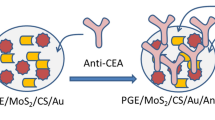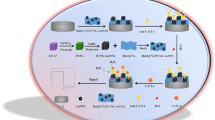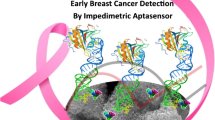Abstract
Since evaluating CA 19-9 antigen level in human serum is crucial for the early diagnosis of a vast range of diseases, especially pancreatic cancer, applying a simple, rapid, and sensitive detection method is essential. We employed an electrolyte-gated field-effect transistor with MoS2 nanosheets channel as an immunosensor to recognize CA 19-9 tumor marker. In order to obtain MoS2 nanosheets and use them as a semiconducting channel, the liquid phase exfoliation method was performed. Later, the MoS2 channel surface was modified by covalent immobilization of antibody 19-9. Electrical measurements revealed the depletion mode n-type behavior of MoS2 nanosheets with the FET mobility of 0.02 cm2 V-1 s-1, current on/off ratio of 883.96, and the subthreshold swing of 795.54 mV/decade. Due to the n-type behavior of the MoS2-based FET immunosensor, with increasing the concentration of the CA 19-9 antigen at a wide linear concentration range from 1.0×10-12 U/ml to 1.0×10-4 U/ml, the source-drain current decreased and low detection limit of 2.8×10-13 U/ml was obtained. The designed MoS2-based FET immunosensor, owning high selectivity, performed accurately for trace amounts of real human serum samples. The remarkable properties of this immunosensor enable the diagnosis of pancreatic cancer in the early stages, which increases the chance of curing this disease.
Graphical Abstract






Similar content being viewed by others
References
Ryan DP, Hong TS, Bardeesy N (2014) Pancreatic adenocarcinoma. N Engl J Med 371:1039–1049. https://doi.org/10.1056/NEJMra1404198
Siegel RL, Miller KD, Jemal A (2016) Cancer statistics, 2016. CA Cancer J Clin 66:7–30. https://doi.org/10.3322/caac.21332
Li D, **e K, Wolff R et al (2004) Pancreatic cancer. Lancet 363:1049–1057. https://doi.org/10.1016/S0140-6736(04)15841-8
Schrag D (2016) Optimizing Treatment for Locally Advanced Pancreas Cancer: Progress but No Precision. JAMA 315:1837–1838. https://doi.org/10.1001/jama.2016.4284
**ng H, Wang J, Wang Y et al (2018) Diagnostic Value of CA 19-9 and Carcinoembryonic Antigen for Pancreatic Cancer: A Meta-Analysis. Gastroenterol Res Pract 2018:8704751. https://doi.org/10.1155/2018/8704751
Ballehaninna UK, Chamberlain RS (2012) The clinical utility of serum CA 19-9 in the diagnosis, prognosis and management of pancreatic adenocarcinoma: An evidence based appraisal. J Gastrointest Oncol 3:105–119. https://doi.org/10.3978/j.issn.2078-6891.2011.021
Katz MH, Varadhachary GR, Fleming JB et al (2010) Serum CA 19-9 as a marker of resectability and survival in patients with potentially resectable pancreatic cancer treated with neoadjuvant chemoradiation. Ann Surg Oncol 17:1794–1801. https://doi.org/10.1245/s10434-010-0943-1
Choe JW, Kim JS, Kim HJ et al (2016) Value of Early Check-Up of Carbohydrate Antigen 19-9 Levels for Pancreatic Cancer Screening in Asymptomatic New-Onset Diabetic Patients. Pancreas 45:730–734. https://doi.org/10.1097/MPA.0000000000000538
Marchegiani G, Andrianello S, Malleo G et al (2017) Does size matter in pancreatic cancer? Ann Surg 266:142–148. https://doi.org/10.1097/SLA.0000000000001837
Ferrone CR, Finkelstein DM, Thayer SP et al (2006) Perioperative CA19-9 levels can predict stage and survival in patients with resectable pancreatic adenocarcinoma. J Clin Oncol: Off J Am Soc Clin Oncol 24. https://doi.org/10.1200/JCO.2005.05.3934
Schlieman MG, Ho HS, Bold RJ (2003) Utility of tumor markers in determining resectability of pancreatic cancer. Arch Surg 138:951–955; discussion 955-956. https://doi.org/10.1001/archsurg.138.9.951
Park JK, Paik WH, Ryu JK et al (2013) Clinical significance and revisiting the meaning of CA 19-9 blood level before and after the treatment of pancreatic ductal adenocarcinoma: analysis of 1,446 patients from the pancreatic cancer cohort in a single institution. PLoS One 8:e78977. https://doi.org/10.1371/journal.pone.0078977
Tzeng CW, Balachandran A, Ahmad M et al (2014) Serum carbohydrate antigen 19-9 represents a marker of response to neoadjuvant therapy in patients with borderline resectable pancreatic cancer. HPB (Oxford) 16:430–438. https://doi.org/10.1111/hpb.12154
Chung KH, Ryu JK, Lee BS et al (2016) Early decrement of serum carbohydrate antigen 19-9 predicts favorable outcome in advanced pancreatic cancer. J Gastroenterol Hepatol 31:506–512. https://doi.org/10.1111/jgh.13075
Song S-P, Li B, Hu J et al (2004) Simultaneous multianalysis for tumor markers by antibody fragments microarray system. Anal Chim Acta 510:147–152. https://doi.org/10.1016/j.aca.2004.01.020
Nishizono I, Iida S, Suzuki N et al (1991) Rapid and sensitive chemiluminescent enzyme immunoassay for measuring tumor markers. Clin Chem 37:1639–1644. https://doi.org/10.1093/clinchem/37.9.1639
Lin J, Yan F, Hu X et al (2004) Chemiluminescent immunosensor for CA19-9 based on antigen immobilization on a cross-linked chitosan membrane. J Immunol Methods 291:165–174. https://doi.org/10.1016/j.jim.2004.06.001
Zhang A, **ang H, Zhang X et al (2016) A novel sandwich electrochemiluminescence immunosensor for ultrasensitive detection of carbohydrate antigen 19-9 based on immobilizing luminol on Ag@BSA core/shell microspheres. Biosens Bioelectron 75:206–212. https://doi.org/10.1016/j.bios.2015.08.047
Sha Y, Guo Z, Chen B et al (2015) A one-step electrochemiluminescence immunosensor preparation for ultrasensitive detection of carbohydrate antigen 19-9 based on multi-functionalized graphene oxide. Biosens Bioelectron 66:468–473. https://doi.org/10.1016/j.bios.2014.12.013
Ohkura H, Sakawaki O, Ozaki H (1985) Enzyme immunoassay of CA19-9. Enzyme immunoassay and its clinical application. Kan, Tan, Sui, Japan 11:21–28
Chung J, Bernhardt R, Pyun J (2006) Additive assay of cancer marker CA 19-9 by SPR biosensor. Sens Actuators B: Chem 118:28–32. https://doi.org/10.1016/j.snb.2006.04.015
Bahari D, Babamiri B, Salimi A (2020) An eco-friendly MIP-solid surface fluorescence immunosensor for detection of CA 19-9 tumor marker using Ni nanocluster as an emitter labels. J Ir Chem Soc 17:2283–2291. https://doi.org/10.1007/s13738-020-01924-z
Masurkar N, Varma S, Mohana Reddy Arava L (2020) Supported and suspended 2D material-based FET biosensors. Electrochem 1:260–277. https://doi.org/10.3390/electrochem1030017
Karaman O, Özcan N, Karaman C et al (2022) Electrochemical cardiac troponin I immunosensor based on nitrogen and boron-doped graphene quantum dots electrode platform and Ce-doped SnO2/SnS2 signal amplification. Mater Today Chem 23:100666. https://doi.org/10.1016/j.mtchem.2021.100666
Karaman C, Yola BB, Karaman O et al (2021) Sensitive sandwich-type electrochemical SARS-CoV-2 nucleocapsid protein immunosensor. Microchim Acta 188:1–13. https://doi.org/10.1007/s00604-021-05092-6
Boyacıoğlu H, Yola BB, Karaman C et al (2022) A novel electrochemical kidney injury molecule-1 (KIM-1) immunosensor based covalent organic frameworks-gold nanoparticles composite and porous NiCo2S4@ CeO2 microspheres: The monitoring of acute kidney injury. Appl Surf Sci 578:152093. https://doi.org/10.1016/j.apsusc.2021.152093
Karaman C, Bölükbaşı ÖS, Yola BB et al (2022) Electrochemical neuron-specific enolase (NSE) immunosensor based on CoFe2O4@ Ag nanocomposite and AuNPs@ MoS2/rGO. Anal Chim Acta 1200:339609. https://doi.org/10.1016/j.aca.2022.339609
Yola BB, Karaman C, Özcan N et al (2022) Electrochemical Tau Protein Immunosensor Based on MnS/GO/PANI and Magnetite-incorporated Gold Nanoparticles. Electroanalysis 34:1519–1528. https://doi.org/10.1002/elan.202200159
Kalyani T, Sangili A, Nanda A et al (2021) Bio-nanocomposite based highly sensitive and label-free electrochemical immunosensor for endometriosis diagnostics application. Bioelectrochemistry 139:107740. https://doi.org/10.1016/j.bioelechem.2021.107740
Bölükbaşi ÖS, Yola BB, Karaman C et al (2022) Electrochemical α-fetoprotein immunosensor based on Fe3O4NPs@ covalent organic framework decorated gold nanoparticles and magnetic nanoparticles including SiO2@ TiO2. Microchimica Acta 189:242. https://doi.org/10.1007/s00604-022-05344-z
Mao S, Chang J, Pu H et al (2017) Two-dimensional nanomaterial-based field-effect transistors for chemical and biological sensing. Chem Soc Rev 46:6872–6904. https://doi.org/10.1039/c6cs00827e
Rahmani H, Majd SM, Salimi A et al (2023) Ultrasensitive immunosensor for monitoring of CA 19-9 pancreatic cancer marker using electrolyte-gated TiS3 nanoribbons field-effect transistor. Talanta 124336. https://doi.org/10.1016/j.talanta.2023.124336
Seo G, Lee G, Kim MJ et al (2020) Rapid detection of COVID-19 causative virus (SARS-CoV-2) in human nasopharyngeal swab specimens using field-effect transistor-based biosensor. ACS nano 14:5135–5142. https://doi.org/10.1021/acsnano.0c02823
Shen Y, Tran TT, Modha S et al (2019) A paper-based chemiresistive biosensor employing single-walled carbon nanotubes for low-cost, point-of-care detection. Biosens Bioelectron 130:367–373. https://doi.org/10.1016/j.bios.2018.09.041
Majd SM, Salimi A, Astinchap B (2018) The development of radio frequency magnetron sputtered p-type nickel oxide thin film field-effect transistor device combined with nucleic acid probe for ultrasensitive label-free HIV-1 gene detection. Sens Actuators B: Chem 266:178–186. https://doi.org/10.1016/j.snb.2018.03.111
Xu JJ, Luo XL, Chen HY (2005) Analytical aspects of fet-based biosensors. Front Biosci 10:420–430. https://doi.org/10.2741/1538
Wilson JA, Yoffe A (1969) The transition metal dichalcogenides discussion and interpretation of the observed optical, electrical and structural properties. Adv Phys 18:193–335
Ataca C, Sahin H, Ciraci S (2012) Stable, single-layer MX2 transition-metal oxides and dichalcogenides in a honeycomb-like structure. J Phys Chem C 116:8983–8999. https://doi.org/10.1021/jp212558p
Larentis S, Fallahazad B, Tutuc E (2012) Field-effect transistors and intrinsic mobility in ultra-thin MoSe2 layers. Appl Phys Lett 101:223104
Novoselov KS, Jiang D, Schedin F et al (2005) Two-dimensional atomic crystals. Proc Natl Acad Sci U S A 102:10451–10453. https://doi.org/10.1073/pnas.0502848102
Benameur MM, Radisavljevic B, Heron JS et al (2011) Visibility of dichalcogenide nanolayers. Nanotechnology 22:125706. https://doi.org/10.1088/0957-4484/22/12/125706
Late DJ, Liu B, Matte HR et al (2012) Rapid characterization of ultrathin layers of chalcogenides on SiO2/Si substrates. Adv Funct Mater 22:1894–1905. https://doi.org/10.1002/adfm.201102913
Li H, Lu G, Yin Z et al (2012) Optical identification of single- and few-layer MoS(2) sheets. Small 8:682–686. https://doi.org/10.1002/smll.201101958
** X, Zhao L, Wang Z et al (2015) Strongly enhanced charge-density-wave order in monolayer NbSe 2. Nat Nanotechnol 10:765–769. https://doi.org/10.1038/nnano.2015.143
Li H, Tan Y, Liu P et al (2016) Atomic-Sized Pores Enhanced Electrocatalysis of TaS(2) Nanosheets for Hydrogen Evolution. Adv Mater 28:8945–8949. https://doi.org/10.1002/adma.201602502
Stephenson T, Li Z, Olsen B et al (2014) Lithium ion battery applications of molybdenum disulfide (MoS 2) nanocomposites. Energy Environ Sci 7:209–231. https://doi.org/10.1039/C3EE42591F
Chang YH, Lin CT, Chen TY et al (2013) Highly efficient electrocatalytic hydrogen production by MoS(x) grown on graphene-protected 3D Ni foams. Adv Mater 25:756–760. https://doi.org/10.1002/adma.201202920
Manzeli S, Ovchinnikov D, Pasquier D et al (2017) 2D transition metal dichalcogenides. Nat Rev Mater 2:1–15. https://doi.org/10.1038/natrevmats.2017.33
Kannan PK, Late DJ, Morgan H et al (2015) Recent developments in 2D layered inorganic nanomaterials for sensing. Nanoscale 7:13293–13312. https://doi.org/10.1039/c5nr03633j
Sun Y, Gao S, Lei F et al (2015) Atomically-thin two-dimensional sheets for understanding active sites in catalysis. Chem Soc Rev 44:623–636. https://doi.org/10.1039/c4cs00236a
Gupta D, Chauhan V, Kumar R (2020) A comprehensive review on synthesis and applications of molybdenum disulfide (MoS2) material: Past and recent developments. Inorg Chem Commun 121:108200. https://doi.org/10.1016/j.inoche.2020.108200
Samy O, Zeng S, Birowosuto MD et al (2021) A Review on MoS2 properties, synthesis, sensing applications and challenges. Crystals 11:355. https://doi.org/10.3390/cryst11040355
Frindt R (1966) Single crystals of MoS2 several molecular layers thick. J Appl Phys 37:1928–1929. https://doi.org/10.1063/1.1708627
Zhang X, Lai Z, Tan C et al (2016) Solution-Processed Two-Dimensional MoS2 Nanosheets: Preparation, Hybridization, and Applications. Angew Chem Int Ed Engl 55:8816–8838. https://doi.org/10.1002/anie.201509933
Radisavljevic B, Radenovic A, Brivio J et al (2011) Single-layer MoS2 transistors. Nat Nanotechnol 6:147–150. https://doi.org/10.1038/nnano.2010.279
Ishag A, Sun Y (2021) Recent Advances in Two-Dimensional MoS2 Nanosheets for Environmental Application. Ind Eng Chem Res 60:8007–8026. https://doi.org/10.1021/acs.iecr.1c01311
Wang Z, Mi B (2017) Environmental Applications of 2D Molybdenum Disulfide (MoS(2)) Nanosheets. Environ Sci Technol 51:8229–8244. https://doi.org/10.1021/acs.est.7b01466
Gao X, Wang X, Ouyang X et al (2016) Flexible Superhydrophobic and Superoleophilic MoS2 Sponge for Highly Efficient Oil-Water Separation. Sci Rep 6:27207. https://doi.org/10.1038/srep27207
Kaasbjerg K, Thygesen KS, Jacobsen KW (2012) Phonon-limited mobility in n-type single-layer MoS 2 from first principles. Phys Rev B 85:115317. https://doi.org/10.1103/PhysRevB.85.115317
Li X, Mullen JT, ** Z et al (2013) Intrinsic electrical transport properties of monolayer silicene and MoS 2 from first principles. Phys Rev B 87:115418. https://doi.org/10.1103/PhysRevB.87.115418
Ma N, Jena D (2014) Charge scattering and mobility in atomically thin semiconductors. Phys Rev X 4:011043. https://doi.org/10.1103/PhysRevX.4.011043
Gopalakrishnan D, Damien D, Shaijumon MM (2014) MoS2 quantum dot-interspersed exfoliated MoS2 nanosheets. ACS Nano 8:5297–5303. https://doi.org/10.1021/nn501479e
Cravanzola S, Muscuso L, Cesano F et al (2015) MoS2 Nanoparticles Decorating Titanate-Nanotube Surfaces: Combined Microscopy, Spectroscopy, and Catalytic Studies. Langmuir 31:5469–5478. https://doi.org/10.1021/acs.langmuir.5b00396
Wilcoxon J, Samara G (1995) Strong quantum-size effects in a layered semiconductor: MoS 2 nanoclusters. Phys Rev B 51:7299. https://doi.org/10.1103/PhysRevB.51.7299
Mak KF, Lee C, Hone J et al (2010) Atomically thin MoS 2: a new direct-gap semiconductor. Phys Rev Lett 105:136805. https://doi.org/10.1103/PhysRevLett.105.136805
Fadil D, Hossain RF, Saenz GA et al (2017) On the chemically-assisted excitonic enhancement in environmentally-friendly solution dispersions of two-dimensional MoS 2 and WS 2. J Mater Chem C 5:5323–5333. https://doi.org/10.1039/C7TC01001J
Porrazzo R, Bellani S, Luzio A et al (2014) Improving mobility and electrochemical stability of a water-gated polymer field-effect transistor. Org Electron 15:2126–2134. https://doi.org/10.1016/j.orgel.2014.06.002
Yang F, Yang Z, Zhuo Y et al (2015) Ultrasensitive electrochemical immunosensor for carbohydrate antigen 19-9 using Au/porous graphene nanocomposites as platform and Au@ Pd core/shell bimetallic functionalized graphene nanocomposites as signal enhancers. Biosens Bioelectron 66:356–362. https://doi.org/10.1016/j.bios.2014.10.066
Zhuo Y, Yuan R, Chai Y-Q et al (2010) Functionalized SiO 2 labeled CA19-9 antibodies: A new strategy for signal amplification of antigen–antibody sensing processes. Analyst 135:2036–2042. https://doi.org/10.1039/C0AN00022A
Alarfaj NA, El-Tohamy MF, Oraby HF (2018) CA 19-9 Pancreatic Tumor Marker Fluorescence Immunosensing Detection via Immobilized Carbon Quantum Dots Conjugated Gold Nanocomposite. Int J Mol Sci 19:1162. https://doi.org/10.3390/ijms19041162
Acknowledgements
We thank the Vice President for Research and Technology of Ministry of Science, Research, and Technology of Iran for support of Samira Mansouri Majd postdoctoral program [grant number: 3/294449]. The research office of University of Kurdistan is also acknowledged.
Author information
Authors and Affiliations
Corresponding authors
Ethics declarations
Competing interests
The authors declare that they have no known competing financial interests or personal relationships that could have appeared to influence the work reported in this paper.
Additional information
Publisher’s note
Springer Nature remains neutral with regard to jurisdictional claims in published maps and institutional affiliations.
Rights and permissions
Springer Nature or its licensor (e.g. a society or other partner) holds exclusive rights to this article under a publishing agreement with the author(s) or other rightsholder(s); author self-archiving of the accepted manuscript version of this article is solely governed by the terms of such publishing agreement and applicable law.
About this article
Cite this article
Rahmani, H., Majd, S.M. & Salimi, A. Highly sensitive and selective detection of the pancreatic cancer biomarker CA 19-9 with the electrolyte-gated MoS2-based field-effect transistor immunosensor. Ionics 29, 3769–3779 (2023). https://doi.org/10.1007/s11581-023-05136-2
Received:
Revised:
Accepted:
Published:
Issue Date:
DOI: https://doi.org/10.1007/s11581-023-05136-2




